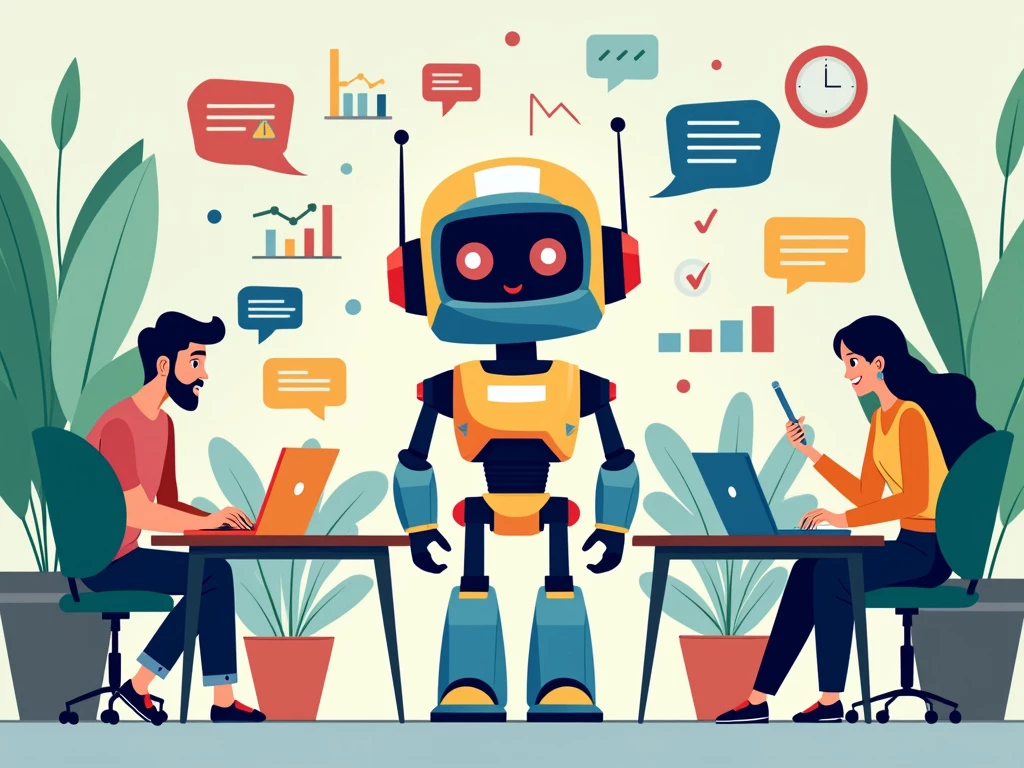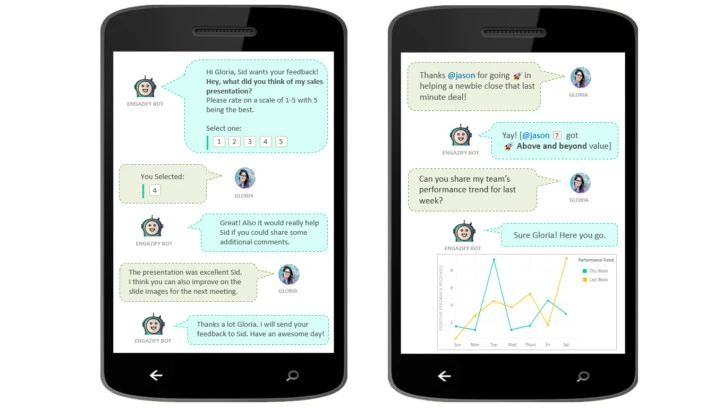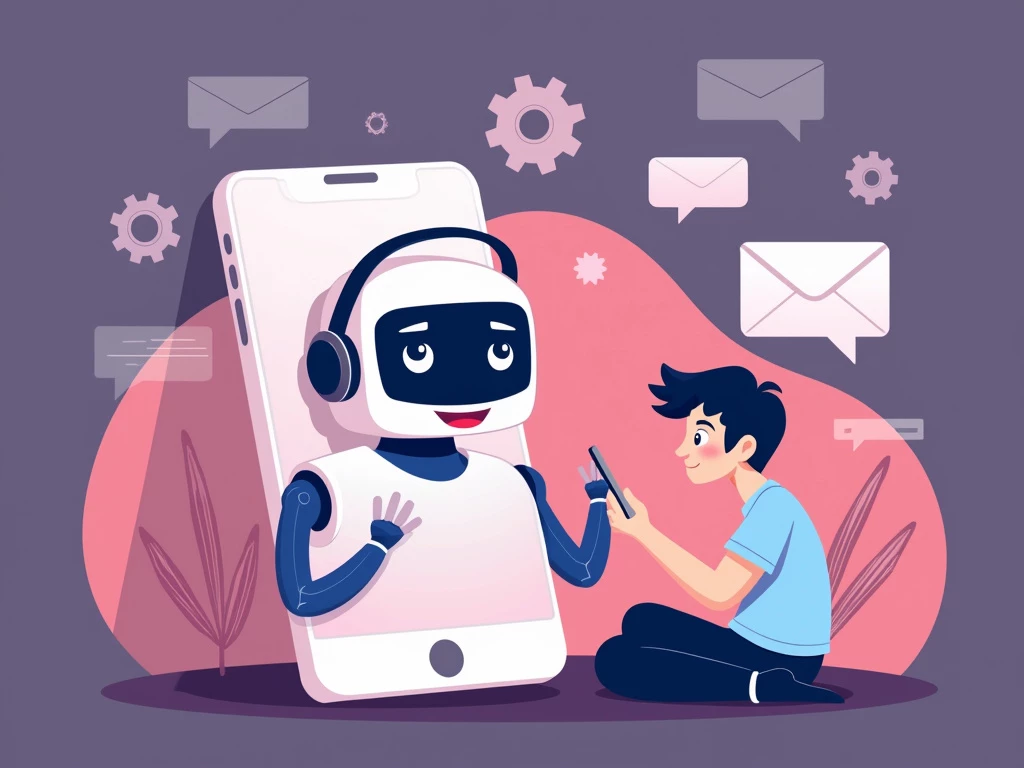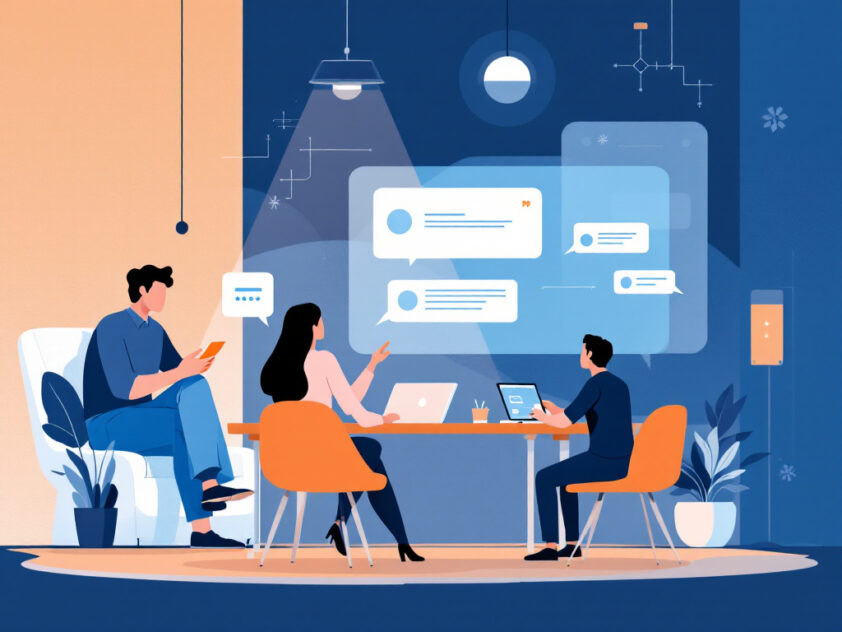Imagine a world where your HR questions get answered instantly, day or night. That’s the power of chatbots in HR. These smart digital helpers are changing how companies handle human resources. They’re like tireless assistants that never sleep, always ready to help employees and job seekers.
Chatbots are transforming HR departments everywhere by taking over repetitive tasks and freeing up humans to focus on more important work. From assisting new hires to identifying top job candidates, these AI-powered tools are enhancing HR efficiency and speed.
But what exactly can these chatbots do? And are there any downsides to using them? In this article, we’ll explore:
- How chatbots are making HR tasks easier
- Innovative ways companies are using chatbots
- Challenges of integrating chatbots into HR
- Success stories of businesses using chatbots
Discover how these digital helpers are transforming the way companies manage their most important asset – their people. Whether you’re a manager, an HR professional, or just curious about the future of work, you’ll want to learn about this game-changing technology.
Benefits of HR Chatbots: Revolutionizing Human Resources
HR departments are constantly seeking innovative ways to streamline operations and enhance employee experiences. Enter HR chatbots – the technology reshaping human resources. These AI-powered virtual assistants are proving to be indispensable tools for modern HR professionals.
Here are the remarkable benefits that HR chatbots bring:
Supercharging Efficiency
Imagine HR professionals not bogged down by routine inquiries. HR chatbots automate responses to frequently asked questions, freeing up valuable time for HR teams. No more spending hours explaining the same vacation policy or benefits package – chatbots handle it all, 24/7.
For instance, at Airbus, their chatbot ‘Bessie’ tackles a whopping 60% of candidate questions outside regular hours. This means HR staff can focus on complex, strategic tasks that require a human touch, like developing talent acquisition strategies or improving company culture.
Slashing Costs, Boosting Savings
HR chatbots are a CFO’s dream. By automating time-consuming processes, these AI assistants significantly reduce operational costs. General Motors’ chatbot ‘Ev-e’ has saved the company over $2 million in hard costs since its implementation. That’s a game-changing level of savings that can be reinvested into other critical areas of the business.
Elevating Employee Satisfaction
Nobody likes waiting for answers to simple questions. HR chatbots eliminate that frustration by providing instant, accurate responses to employee queries. Whether it’s checking remaining vacation days or understanding the latest health insurance update, employees get the information they need, when they need it.
These chatbots also offer impressive personalization. They can tailor responses based on an employee’s role, tenure, and specific circumstances, creating a more engaging and satisfying experience. It’s like having a personal HR assistant for every employee, without the astronomical cost.
Streamlining the Recruitment Process
Finding the right talent is crucial but time-consuming. HR chatbots can efficiently screen candidates, schedule interviews, and even conduct initial assessments. This accelerates the hiring process and ensures that human recruiters spend their time engaging with the most promising candidates.
McDonald’s, for instance, has seen remarkable results with their recruiting chatbot. What once took 3 days to schedule an interview now takes just 3 minutes. That’s not just efficiency; it’s a complete transformation of the recruitment landscape.
Empowering HR Professionals
Contrary to some fears, HR chatbots aren’t replacing human HR professionals – they’re empowering them. By handling routine tasks, chatbots allow HR teams to focus on strategic planning, employee development, and fostering a positive workplace culture. It’s about augmenting human capabilities, not replacing them.
“HR chatbots are not just tools; they’re partners in creating more efficient, responsive, and employee-centric HR departments. They’re liberating HR professionals to be the strategic partners businesses need in the 21st century.”
Anton Hapieiev, Delivery Director at Yalantis
As we look to the future, it’s clear that HR chatbots are becoming an integral part of modern HR departments, offering unprecedented efficiency, cost savings, and improved employee experiences. For businesses looking to stay competitive and create thriving workplaces, embracing this technology is not just an option – it’s a necessity.
The revolution in HR is here, and it’s powered by AI. Are you ready to join?
Challenges in Implementing HR Chatbots

HR chatbots offer exciting possibilities for streamlining operations, but their implementation comes with challenges. Let’s explore the key obstacles organizations face when integrating these AI assistants.
Integration Headaches
Seamlessly integrating chatbots with existing HR systems is a significant roadblock. Compatibility issues between legacy software and AI tools often arise. It’s like teaching a new language to someone who only speaks in code.
This integration requires meticulous planning and sometimes a complete overhaul of existing infrastructure. Cross-functional teams of HR professionals, IT experts, and chatbot developers must collaborate closely, mapping out data flows, identifying potential bottlenecks, and creating bridges between systems.
Data Privacy: Walking a Tightrope
Protecting sensitive employee information is crucial in an era of frequent data breaches. HR chatbots handle personal data, from salary details to performance reviews. The challenge is balancing accessibility and security. Implementing robust encryption protocols and strict access controls is essential. Organizations must also navigate data protection regulations like GDPR in Europe or CCPA in California. One misstep could lead to severe legal and reputational consequences.
Accuracy: The Make-or-Break Factor
An HR chatbot’s value depends on the accuracy of the information it provides. Inaccurate responses can cause confusion, frustration, and legal issues if employees act on incorrect information. Ensuring accuracy requires continuous monitoring and refinement. HR teams must regularly review interactions, update knowledge bases, and fine-tune algorithms. The chatbot must adapt to evolving HR policies and procedures, making it a never-ending process of learning.
The Human Touch: Finding the Right Balance
While chatbots excel at handling routine queries, they can struggle with nuanced or emotionally charged situations. Organizations must carefully consider which tasks are suitable for automation and which require a human touch. It’s about augmenting HR capabilities, not replacing human judgment and empathy. A hybrid system where chatbots handle initial inquiries but escalate complex issues to human HR professionals combines efficiency with the personal touch employees need in sensitive situations.
Overcoming the Challenges: A Collaborative Effort
Successfully implementing HR chatbots requires a concerted effort across multiple departments: HR professionals understand employee needs and company policies, IT teams provide technical expertise for integration and security, legal departments navigate data protection regulations, and training teams develop programs to help employees embrace the new technology. Open communication and collaboration between these groups allow organizations to tackle challenges and unlock the full potential of HR chatbots.
While the road to implementation may be bumpy, the destination—a more efficient, responsive, and employee-centric HR function—is worth the journey. With careful planning, ongoing refinement, and a commitment to balancing technology with the human touch, HR chatbots can revolutionize the way organizations support and engage their workforce.
Applications of HR Chatbots
HR chatbots are transforming how human resources departments operate by streamlining processes and enhancing the employee experience. These AI-powered assistants are proving invaluable across the entire employee lifecycle, from recruitment to retirement. Here are some key applications where HR chatbots are making a significant impact.
Enhancing Recruitment
In talent acquisition, speed and efficiency are crucial. HR chatbots automate time-consuming tasks and provide a more engaging candidate experience. Imagine a job seeker visiting your careers page at 2 AM. Instead of waiting until business hours for answers, they can interact with a chatbot immediately.
These AI assistants can:
- Answer frequently asked questions about job openings, company culture, and benefits
- Screen candidates by asking preliminary questions and assessing qualifications
- Schedule interviews without the back-and-forth email chains
- Provide timely updates on application status
The result is a faster, more responsive hiring process that keeps top talent engaged. For example, Unilever implemented a recruitment chatbot that reduced their hiring time from 4 months to 4 weeks while increasing candidate engagement by 100%.
Streamlining Onboarding
A smooth onboarding process sets the stage for a positive employee experience. HR chatbots guide new hires through their initial days and weeks, providing on-demand support when human HR staff might be unavailable.
Onboarding chatbots can:
- Walk employees through paperwork and compliance training
- Provide information on company policies and procedures
- Introduce new hires to team members and company culture
- Answer questions about benefits, IT setup, and other common concerns
By automating these routine tasks, HR professionals can focus on more strategic aspects of onboarding, such as team integration and role-specific training. This leads to faster time-to-productivity and higher employee satisfaction.
Improving Performance Management
Performance management is an ongoing process, not just an annual review. HR chatbots facilitate regular check-ins, gather feedback, and provide coaching suggestions.
In performance management, chatbots can:
- Send reminders for goal-setting and review sessions
- Collect peer feedback for 360-degree reviews
- Provide instant access to performance metrics and KPIs
- Offer suggestions for skill development based on performance data
| Statistic | Percentage | Source |
|---|---|---|
| Organizations that believe performance management is important | 98% | ClearCompany |
| Employees preferring immediate feedback over annual reviews | 80% | EmploySure |
| Workers thinking traditional reviews have no impact on their performance | 59% | TruQu |
| HR managers making changes to traditional performance management | 81% | Gartner |
| HR managers believing continuous performance management is more useful | 89% | HR Research Institute |
| HR managers agreeing on the importance of mentorship culture | 75% | Cision |
| Workers needing to wait over three months for feedback | 32% | OfficeVibe |
| Employees wanting feedback at least every month | 76% | TruQu |
This real-time approach to performance management helps employees stay on track and feel more supported in their professional growth. It also provides managers with more frequent touchpoints to guide their teams effectively.
Boosting Employee Engagement
Engaged employees are productive employees. HR chatbots play an increasingly important role in keeping the workforce connected, informed, and motivated. They serve as always-on companions that employees can turn to for information and support.
Engagement-focused chatbots can:
- Conduct pulse surveys to gauge employee sentiment
- Provide information on company news and events
- Facilitate peer recognition programs
- Offer wellness tips and resources
By providing these services through a conversational interface, chatbots make it easier for employees to stay engaged with their work and the company culture. For instance, Honest Burgers, a UK restaurant chain, used a chatbot to deliver bite-sized training modules, resulting in a 73% engagement rate among staff.
Streamlining HR Operations
Beyond these specific applications, HR chatbots are invaluable in handling a wide range of day-to-day HR operations. They are becoming the first point of contact for employees seeking information or assistance.
Operational HR chatbots can:
- Process leave requests and provide balance information
- Answer questions about payroll and benefits
- Guide employees through expense reporting
- Assist with internal job applications and transfers
By automating these routine inquiries, HR chatbots free up human HR professionals to focus on more complex issues and strategic initiatives. This not only improves efficiency but also enhances the overall employee experience by providing quick, consistent responses to common queries.
Ultimately, HR chatbots are becoming essential tools in the modern HR toolkit. By handling routine tasks, providing instant support, and gathering valuable data, these AI assistants enable HR departments to work more strategically and effectively. As the technology continues to evolve, HR chatbots will play an even more significant role in shaping the future of work.
Best Practices for Using HR Chatbots
Implementing HR chatbots can transform how organizations manage human resources, but success hinges on following key best practices. By taking a measured, employee-centric approach, companies can maximize the benefits of this technology while ensuring smooth adoption. Here are some essential strategies for effective HR chatbot utilization.
Gradual Implementation: Start Small, Scale Smart
When introducing HR chatbots, a phased rollout is crucial. Begin with a pilot program in a single department or for specific HR functions. This approach allows you to:
- Identify and address potential issues early
- Gather valuable feedback from a smaller user group
- Refine the chatbot’s responses and functionality
- Build confidence among employees and stakeholders
As Gartner predicts that by 2027, chatbots will handle over 70% of all HR-related inquiries, a careful implementation strategy is paramount. Start with commonly asked questions about policies or benefits, then gradually expand the chatbot’s capabilities based on user needs and feedback.
Continuous Monitoring: The Key to Ongoing Improvement
Once your HR chatbot is up and running, vigilant monitoring is essential. This practice involves:
- Regularly analyzing chatbot interactions for accuracy and relevance
- Identifying patterns in user queries to improve response libraries
- Tracking key performance indicators (KPIs) like response times and user satisfaction
- Staying alert for any biases or inconsistencies in chatbot responses
Remember, an HR chatbot is not a ‘set it and forget it’ solution. It requires ongoing attention to ensure it remains a valuable tool for your workforce.
Soliciting and Incorporating Employee Feedback
Your employees are the primary users of HR chatbots, making their input invaluable. To effectively gather and utilize feedback:
- Implement easy-to-use feedback mechanisms within the chatbot interface
- Conduct regular surveys to assess user satisfaction and gather improvement suggestions
- Create focus groups to dive deeper into user experiences and expectations
- Act on feedback promptly to show employees their input is valued
A study by IBM revealed that 66% of HR executives believe chatbots deliver substantial value in employee engagement. By actively seeking and incorporating employee feedback, you can significantly enhance this engagement and ensure your chatbot meets real user needs.
Maintain a Human Touch
While chatbots excel at handling routine queries, it’s crucial to maintain a balance between automation and human interaction. Ensure your HR chatbot can seamlessly escalate complex issues to human HR professionals when necessary. This approach helps prevent frustration and maintains the personal touch that’s often crucial in HR matters.
Prioritize Data Security and Privacy
HR chatbots often handle sensitive employee information. Implement robust security measures to protect this data, including:
- End-to-end encryption for all chatbot interactions
- Clear privacy policies that are easily accessible to employees
- Regular security audits and updates
- Compliance with relevant data protection regulations
By prioritizing security, you build trust in the system and encourage adoption among privacy-conscious employees.
The key to successful HR chatbot implementation is not just in the technology itself, but in how we introduce, refine, and integrate it into our existing HR processes. It’s about enhancing, not replacing, the human element in HR.
HR Technology Expert
HR chatbots offer immense potential to streamline operations and improve employee experiences. By following these best practices – gradual implementation, continuous monitoring, soliciting employee feedback, maintaining a human touch, and prioritizing security – organizations can harness the full power of this technology. The goal is to create a symbiotic relationship between AI and human HR professionals, ultimately leading to a more efficient, responsive, and employee-centric HR function.
Future Trends in HR Chatbots

Advancements in AI, machine learning, and natural language processing are transforming human resources. These technologies are leading to a new generation of HR chatbots that are more intuitive, capable, and impactful.
Natural language processing (NLP) capabilities are evolving, enabling future HR chatbots to understand and respond to complex queries accurately. Imagine an AI assistant that answers basic questions about leave policies and offers personalized career advice based on an employee’s skills and aspirations.
Machine learning algorithms will make HR chatbots increasingly intelligent over time. These AI assistants will learn from each interaction, improving their responses and anticipating employee needs. For instance, a chatbot might remind an employee about upcoming deadlines or suggest relevant training opportunities based on recent project work.
Integrating predictive analytics with HR chatbots could revolutionize workforce planning and employee retention. By analyzing vast amounts of data, advanced chatbots could alert HR managers to potential turnover risks or identify high-potential employees ready for new challenges. This proactive approach could enhance employee satisfaction and organizational effectiveness.
Emotionally intelligent chatbots are another trend to watch. These AI assistants will recognize and respond to employee emotions, offering empathetic support when needed. This could be valuable in sensitive situations, such as addressing workplace conflicts or providing mental health resources.
| Benefit | Description |
|---|---|
| Supercharging Efficiency | HR chatbots automate responses to frequently asked questions, freeing up valuable time for HR teams. |
| Slashing Costs, Boosting Savings | By automating time-consuming processes, HR chatbots significantly reduce operational costs. |
| Elevating Employee Satisfaction | HR chatbots provide instant, accurate responses to employee queries, enhancing the overall employee experience. |
| Streamlining the Recruitment Process | HR chatbots efficiently screen candidates, schedule interviews, and conduct initial assessments. |
| Empowering HR Professionals | By handling routine tasks, HR chatbots allow HR teams to focus on strategic planning and employee development. |
| Enhancing Performance Management | HR chatbots facilitate regular check-ins, gather feedback, and provide coaching suggestions. |
| Boosting Employee Engagement | HR chatbots conduct pulse surveys, provide company news, and facilitate peer recognition programs. |
| Streamlining HR Operations | HR chatbots handle day-to-day HR operations such as processing leave requests and answering payroll questions. |
| Personalization | Advanced AI algorithms enable chatbots to tailor their communication style and recommendations to individual employees. |
As HR chatbots become more sophisticated, they will take on increasingly complex tasks. From conducting initial job interviews to facilitating performance reviews, these AI assistants could streamline many time-consuming HR processes. This shift will allow HR professionals to focus on strategic initiatives and personal interactions.
The future of HR chatbots also holds possibilities for personalization. Advanced AI algorithms will enable chatbots to tailor their communication style and recommendations to individual employees, creating a more engaging and effective user experience. This level of customization could significantly boost employee engagement and satisfaction.
While the potential of these technologies is immense, the human element in HR will remain crucial. HR professionals will likely focus more on strategy, complex problem-solving, and fostering a positive workplace culture. HR chatbots will augment and enhance human capabilities, rather than replace them entirely.
HR chatbots will play an increasingly central role in shaping employee experiences and organizational success. By embracing these technological advancements, companies can create more efficient, responsive, and employee-centric HR functions that drive business growth and foster a thriving workplace culture.
Charting the Future: HR Chatbots and the SmythOS Advantage

Chatbot helps a user with a friendly interaction.
HR chatbots are emerging as transformative agents in human resource management. These AI-powered assistants streamline routine tasks and enhance employee engagement. While implementing HR chatbots presents challenges, the benefits far outweigh the temporary setbacks.
From automating repetitive processes to providing 24/7 support, these digital helpers free HR professionals to focus on strategic initiatives. Future advancements in AI promise even more sophisticated HR chatbot capabilities, including predicting employee needs and offering personalized career guidance. HR’s future is autonomous, intelligent, and employee-centric.
SmythOS is a robust platform simplifying the deployment of HR chatbots. With its intuitive interface and powerful integration capabilities, SmythOS breaks down barriers to AI adoption in HR. Whether you’re a Fortune 500 company or a growing startup, SmythOS provides the tools to seamlessly integrate AI into your HR processes. HR chatbots are not a fleeting trend but a fundamental shift in human resource management. By embracing these technologies, particularly through platforms like SmythOS, businesses can create more responsive, efficient, and empathetic HR departments. The future of work is here, and it speaks the language of AI.
